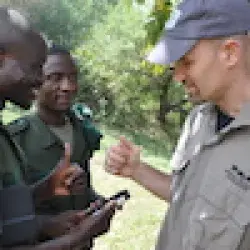Protecting forests by working with the people who live near them
[[{"fid":"67689","view_mode":"full","fields":{"format":"full","alignment":"","field_file_image_alt_text[und][0][value]":"Photo of rural settlement structures in forested areas near Lake Natron in Tanzania","field_file_image_title_text[und][0][value]":"Forest-dependent communities in northern Tanzania help protect biodiversity in reserve buffer zones","field_caption[und][0][value]":"","field_caption[und][0][format]":"full_html"},"type":"media","field_deltas":{"1":{"format":"full","alignment":"","field_file_image_alt_text[und][0][value]":"Photo of rural settlement structures in forested areas near Lake Natron in Tanzania","field_file_image_title_text[und][0][value]":"Forest-dependent communities in northern Tanzania help protect biodiversity in reserve buffer zones","field_caption[und][0][value]":"","field_caption[und][0][format]":"full_html"}},"link_text":null,"attributes":{"alt":"Photo of rural settlement structures in forested areas near Lake Natron in Tanzania","title":"Forest-dependent communities in northern Tanzania help protect biodiversity in reserve buffer zones","class":"media-element file-full","data-delta":"1"}}]]
Forest loss and degradation take various forms across the continent’s landscapes. Industrial logging, mining, and agriculture consume forests to meet the development goals of growing economies. They contribute to climate change and further degrade the forest’s health, resilience, and the services they provide.
For the long-term conservation of these ecosystems, the value of standing, intact forests must exceed that of extractive activities that leave degraded forests. While well-managed, large protected areas are one of the most effective means of restricting large-scale deforestation, neighboring forest-dependent communities can still pose a significant threat.
There are a range of land uses that value community stewardship of healthy, strong forests. In the Chyulu Hills, for example, landowners can sell carbon credits to generate revenue and contribute to the protection of water catchments as part of African Wildlife Foundation’s Reducing Emissions from Deforestation and Forest Degradation (REDD+) project in Kenya.
Restoring forest health with community investment
With the initiation of participatory forest management in the 1990s, Tanzania became one of the first countries in Africa to formally recognize the role of communities in forest management and ownership. Villagers can share responsibilities through joint forest management partnerships between the community and government body that owns the area. For village or private lands, the community-based forest management model enables villagers to participate both as managers and forest owners.
African Wildlife Foundation implemented this approach in two forest reserves within the Lake Natron Wildlife Management Area. Under the oversight of village councils, community members created forest management zones for sensitive areas supporting critical springs and wildlife corridors along with extractive areas for community harvesting of products such as firewood, local medicines, wild fruits and timber for house construction.
Based on this participatory zoning exercise, the village councils and local authorities developed forest management plans and benefit sharing mechanisms. Community members in the Ketumbeine Forest Reserve created economic opportunities from tourist visit and camping fees, as well as from the collection of cedar poles. As Ketumbeine’s forests are a major regional water source, improved stewardship will benefit both the immediate communities and downstream human and wildlife populations.
[[{"fid":"67691","view_mode":"full","fields":{"format":"full","alignment":"","field_file_image_alt_text[und][0][value]":"Photo of young lone bonobo in foliage","field_file_image_title_text[und][0][value]":"Forest fragmentation hinders the movement of the endangered bonobo across its range","field_caption[und][0][value]":"","field_caption[und][0][format]":"full_html"},"type":"media","field_deltas":{"2":{"format":"full","alignment":"","field_file_image_alt_text[und][0][value]":"Photo of young lone bonobo in foliage","field_file_image_title_text[und][0][value]":"Forest fragmentation hinders the movement of the endangered bonobo across its range","field_caption[und][0][value]":"","field_caption[und][0][format]":"full_html"}},"link_text":null,"attributes":{"alt":"Photo of young lone bonobo in foliage","title":"Forest fragmentation hinders the movement of the endangered bonobo across its range","class":"media-element file-full","data-delta":"2"}}]]
Minimizing the risks of wildlife extinction
Unlike Tanzania, the Democratic Republic of Congo lacked a formal land tenure system until the establishment of the Forest Code in 2002. Although this granted communities to manage their own forest concessions, poverty and political unrest hindered the forest zoning process in the country’s Maringa-Lopori-Wamba landscape, a biodiversity hotspot housing the endangered forest elephant and bonobo.
The bonobo’s geographical range spans the landscape, with key connectivity areas linking the Lomako Yokokala Faunal Reserve, located in the central part of the landscape, with the Luo–Iyondji–Kokolopori cluster of reserves towards the east. Without intact forest linkages, the remaining bonobo populations will be fragmented and weakened.
AWF contributed to systematic conservation planning using satellite technology to identify and prioritize these connectivity areas. Within priority linkages, AWF then engaged neighboring communities in participative micro-zoning to define portions of the forest where sustainable agricultural growth is allowed while designating other areas for community-based natural resource management. In these areas, communities monitor and the micro-zone boundaries against illegal encroachment — in exchange, they receive diverse seed types, training in agronomics, and increased access to markets to grow a sustainable livelihood.
[[{"fid":"67694","view_mode":"full","fields":{"format":"full","alignment":"","field_file_image_alt_text[und][0][value]":"Photo of Lupani Community School students planting a seedling","field_file_image_title_text[und][0][value]":"Students at AWF's Classroom Africa school in Lupani are promoting reforestation","field_caption[und][0][value]":"","field_caption[und][0][format]":"full_html"},"type":"media","field_deltas":{"3":{"format":"full","alignment":"","field_file_image_alt_text[und][0][value]":"Photo of Lupani Community School students planting a seedling","field_file_image_title_text[und][0][value]":"Students at AWF's Classroom Africa school in Lupani are promoting reforestation","field_caption[und][0][value]":"","field_caption[und][0][format]":"full_html"}},"link_text":null,"attributes":{"alt":"Photo of Lupani Community School students planting a seedling","title":"Students at AWF's Classroom Africa school in Lupani are promoting reforestation","class":"media-element file-full","data-delta":"3"}}]]
Improving attitudes to conservation
Community empowerment through collaborative micro-zoning and sustainable agriculture gives new meaning to biodiversity conservation. Without clearing woodland for fuel and farming, or hunting for bushmeat, locals settled around reserves are finding more sustainable ways to benefit from the forest. Villagers also learn the importance of forest protection and wildlife through education campaigns.
Instilling these values from an early age is already delivering conservation results at AWF’s Classroom Africa school in Zambia. To combat deforestation caused by charcoal production and agriculture, students at Lupani Community School built a greenhouse for 1,500 indigenous tree seedlings. With support from local education and forest protection agencies in Kazungula, the reforestation program and nursery have the potential to supply 23 other schools in the district.
Recognizing the role of community action in restoring and protecting intact forest ecosystems is the first step. With multilateral environmental agreements across the continent, forest protection can help achieve Africa’s sustainable development goals.
